
22-25 February 2017. About twelve kilometres east of the town of Trinidad there are three long interconnected valleys. They are known collectively as Valle de los Ingenios, or Valley of the Sugar Mills. From the late 1700’s the area was one vast sea of sugar cane, and for over one hundred years it was a major centre of sugar production: at its peak there were more than sixty sugar mills. And 30,000 slaves.
Rapid transport was needed to get the sugar to the coast for export, and from the 1800’s railway lines were constructed through the valley connecting the mills with Trinidad and the nearby port of Casilda.
It was the train that attracted us. We took the train out into the valley to one of the many abandoned sugar mills. We were a bit disappointed that it wasn’t a steam train as had been advertised but the carriages really could have come from the 19th century.
The journey was pleasantly slow. Happy to be out of the city we hung out the glass-free windows on a warm tropical day enjoying the scenery.
There’s not much sugar production these days though we did pass some fields of sugar cane from time to time. There were many ragged farmhouses of not much more than two or three rooms, small plots for vegetables,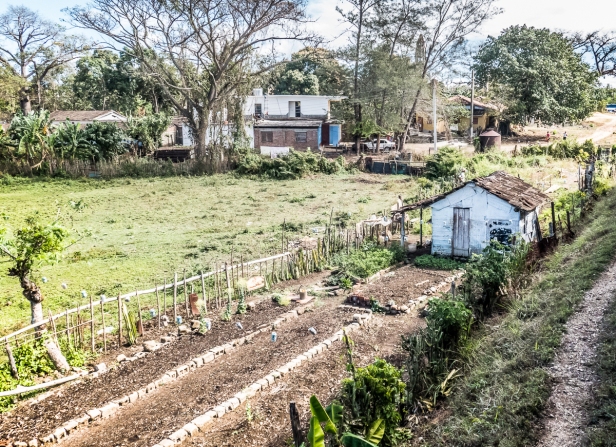
goats, men on horseback, chickens, cattle, the occasional tractor, and one man walking behind a pair of oxen plowing a small holding. From time to time we passed the local “buses” as they trotted along the road parallel to the train.
There was a quite large banana plantation, more than one bumper crop of tomatoes,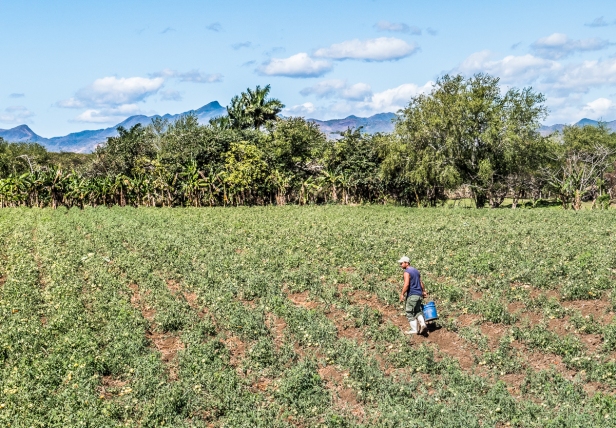
and this man who seemed to be stewing tomatoes in an enormous vat. If you look closely you can see that those pink crates are also full of tomatoes.
We saw a couple of men with their machetes taking a break,
and people hanging out on their porches, or working the land, or coming out to watch the train. I wonder what they thought of us tourists as we went by getting a sneak peek into their lives.
Perhaps it was the wrong time of the year for crops, but we passed vast tracts of empty flat land, acres and acres that went on forever towards the distant mountains. They had obviously once been plowed and farmed but were now fallow and looked mostly unused. There was a poverty here. It felt like the pain of the past still lingered in the air, in the very soil, unlike in Viñales where the income from tourism blesses the entire valley.
Eventually we came to the abandoned sugar mill, all grimy pipes and silos, rusting metal, crumbling buildings, and smoke stacks reaching for the sky. Like any abandoned place it felt sad and forlorn. We wandered around, not understanding anything about how it all worked, only knowing that at one time it had been a vibrant enterprise. This particular mill never knew slavery.



At the mill we were entertained by a group of musicians and offered a chance to drink fresh squeezed cane juice. It’s something that’s readily available in India and we always refused it when we were there because of the threat of food poisoning. One of these days I’ll get up the courage to try it. The contraptions used to squeeze the cane always looked so unsterile, and the one at the sugar mill was no exception. I did note however that many of the people on the train tried the juice and didn’t immediately drop dead from it.
The valley is littered with ruins – sugar mills, the manor houses of the plantation owners, slaves quarters, warehouses, and milling machinery, all disintegrating back into the ground, though we did pass one manor house that has survived.
The owner’s house, some of the slaves’ quarters, and a tower still stand at the plantation of Manaca Iznaga. We stopped there on the way back. The slaves’ quarters, though in need of repair, are now used for housing. The mansion, which has been converted into a restaurant, and the tower, are in good condition.
An iconic landmark that can be seen for miles, the tower is seven stories high. At one point it was the tallest structure in Cuba. The owner of the plantation, Alejo Maria Iznaga y Borrell had it built in 1816. The bell at the top (which now lies on the ground nearby) was used to announce to the slaves the beginning and end of the workday, as a call to prayer, and as an alarm in the case of fire or a slave trying to escape. The tower was also unquestionably a symbol of Iznaga’s power and status in the valley.
We climbed to the top. You can see for miles. Anyone trying to run would likely be spotted. The view was pretty nice though.
Trinidad’s wealth came from this valley. For a brief period, a mere blip in time, in the 19th century the wealth from sugar, on the backs of slaves, allowed a few lucky people to experience vast riches. And then came the Wars of Independence and the area was largely abandoned. Sugar production was revived in the early 1900’s and continued until the middle of the century. At this time the price of sugar plummeted due to the farming of sugar beets in Europe after WWII, and the mills and plantations of Valle de los Ingenios were once again abandoned. Almost all that was built up crumbled back into the earth. What remains are a few structures to remind us of this earlier time, and some very old, very very crooked railway tracks that explained the train’s slow pace.
Our guide’s name was Lenia, after Lenin, her father’s hero. We spent a day with Lenia, and another couple, exploring Guanayara National Park. Our first stop, about eighteen kilometres from Trinidad, was Tope de Collantes, for a view that went on forever, almost 360 degrees of blue wonder punctuated by a soft breeze and soaring vultures. In the distance was Trinidad. In the far distance was the sea.
Next stop, forty-five kilometres later, was the entrance to Parque Guanayara, an area of jungle-covered limestone mountains. We hiked for about three hours along the Centinelas del Río Melodioso trail. In most places we were embraced by lush foliage and dwarfed by the trees, the sentinels of the Melodious River,
as Lenia shared with us her knowledge of the many plants and their uses.
And then suddenly she spotted it. It is one of the great advantages of exploring with a guide – they know what to listen for, what to look for. We would probably not have seen it on our own, and if we had would not have known what it was. What Lenia saw was a tocororo, the red, blue, and white revered national bird of Cuba. The tocororo is the most unique and exotic of the trogons, and ancient people considered it a harbinger of good news.
We continued on and eventually came to the seasonal cottage of a coffee farmer.
The yard was messy, all scattered broken equipment, scratching chickens, muddy ducks,
old broken furniture, a pig half way into its food trough,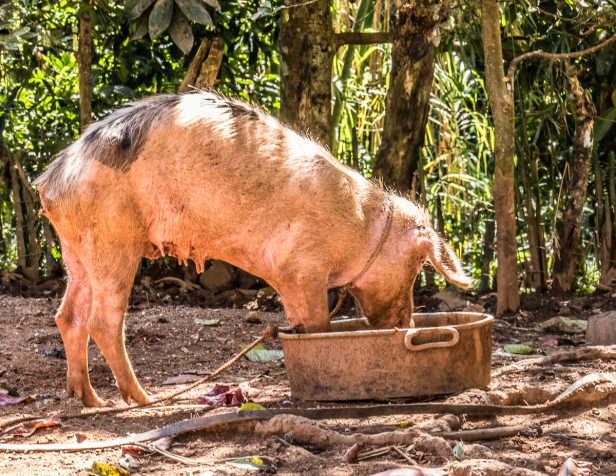
foraging piglets, and a feeling of resigned neglect. The interior of the cottage quickly dispelled that feeling. The cottage was delightful; simple and practical, but neat, clean, and homey. It was clearly well loved. There were three rooms – a kitchen and two bedrooms. The kitchen had a wood stove and a metal workbench. Pots, pans, and plates hung on the wall above a table set with colourful bowls of tomatoes and chilies. I’ve cooked in similar kitchens myself in wilderness hunting camps in the far north of Canada. There’s a warmth and hominess about such places that engenders a cozy contentment, though I daresay cooking on a wood stove in northern Canada is more comfortable than cooking on one in the tropics.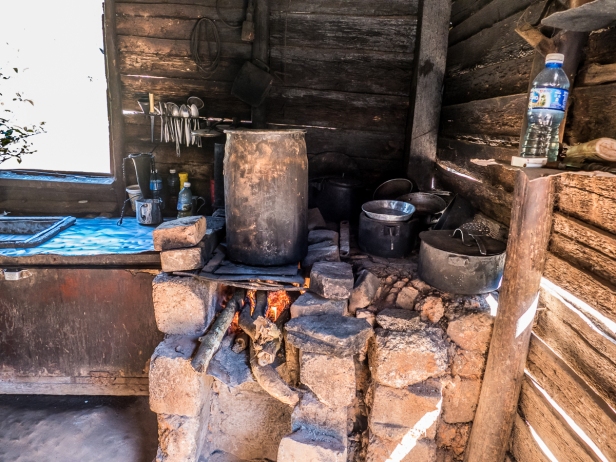

In the first bedroom clothes were piled neatly in the corner and bananas hung from the ceiling to ripen,
and on the opposite wall farm tools filled the wall.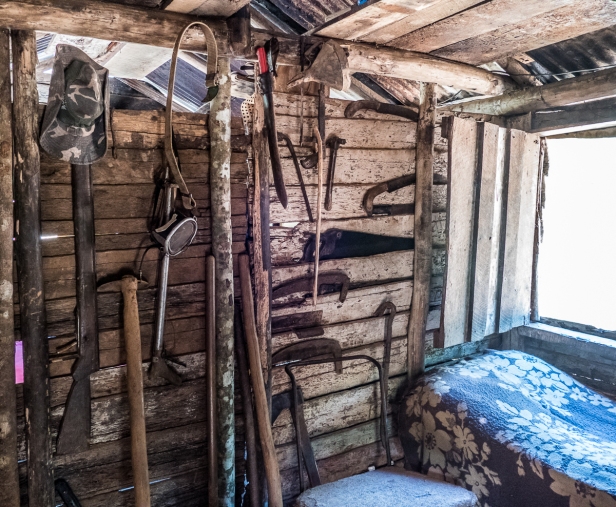
In the second bedroom Shrek and Piglet made snug bed companions.
Walking on we came to a hillside of coffee plants interspersed with trees to provide shade. Shade-grown coffee requires less chemical fertilizer and pesticides, and the trees help with moisture retention.
From the coffee plantations it was a steep downhill hike to the El Rocio Waterfall and plunge pool where we declined to swim given the icy temperature of the water.

We crossed a rickety bridge, walked through a bamboo forest, and eventually came to the end of the trail where we emerged into the gardens of Casa la Gallega, a traditional rural hacienda where we were served a late lunch.
The drive back to Trinidad took us through more gorgeous scenery. The Jeep Safari Guanayara tour turned out to be one of our best days in Cuba.

Next post: One last look at Havana
All words and images by Alison Louise Armstrong unless otherwise noted
© Alison Louise Armstrong and Adventures in Wonderland – a pilgrimage of the heart, 2010-2017.

Thanks for this look into the countryside beyond Trinidad. I’m astonished that you actually rode on a train! We saw lots of tracks throughout Cuba but never with a train running on them. Lucky you to see the tocororo! You have such a way with birds, as shown in so many of your photos, this one included. Great post! Hope you’re enjoying the weekend. ~K.
LikeLiked by 1 person
Thanks Kelly. It’s been a good weekend. Dancing last night and hiking for forty minutes today. Getting better! #brandnewhip
The train was a rickety old thing and the state of the tracks made our jaws drop! The tocororo was an unexpected sweet bonus, and I’m glad I got a good shot, but I look at really good photos of birds and know I’ve got a way to go. A better camera and a tripod would help 🙂
Alison
LikeLiked by 1 person
Dancing?! AWESOME! Congrats to you and your #brandnewhip! 🙂
LikeLiked by 1 person
What a wonderful post. Love it all, especially that you got to see a tocororo.
LikeLiked by 1 person
Thanks so much Peggy. I think I’ll always remember the tocororo moment. It was such a sweet surprise. Added bonus was that I was able to get a decent shot of it.
Alison
LikeLike
Lovely rural scenes Alison. I love your photos.
LikeLike
Thanks so much Arlene. The Cuban countryside is quite lovely.
Alison
LikeLiked by 1 person
What an adventure! Gorgeous photos! And the tocororo! WOW!
LikeLiked by 1 person
Thanks Cindy. Both days were great adventures – we saw lots, getting a glimpse into different parts of Cuba. The tocororo moment was just fabulous. And it sat still for me in a small break through the branches. We were so lucky to see it.
Alison
LikeLike
your photos never fail to amaze me. Love the one with green bananas on the roof. I like how you get the detail but don’t overdo the color. As for squeezed sugar cane, it is a treat, really. Worth the risk. I only tried it once, in India when I was still young and dumb…but only once because it’s more the glass and the way the (don’t quite) wash it–same old dirty water, no soap, by their hand. And all those possible germs send ripples of ick through my brain.
LikeLiked by 1 person
Thanks so much BF. I play a lot in LR with the colour and have to catch myself from over saturating. Sometimes I work on a photo and look at it the next day and have one of these what-was-I-thinking? moments and then pull the colour back to something reasonable. Okay, I’ll try cane juice one day, and see if I can get a clean glass, or clean it myself somehow, or get it squeezed into my water bottle.
Alison
LikeLiked by 1 person
These are beautiful photos. I loved going on the visual trip with you. What an adventure! Thanks for sharing. 🙂
LikeLiked by 1 person
Thanks so much Peggy, I’m glad you enjoyed travelling with us 🙂 Both days were great. We loved exploring beyond the city and getting to see a little more of Cuba in our limited time there.
Alison
LikeLike
Posts like this always tickle that desire to explore within me, not necessarily places far away from home, but places closer from where I live that have been overlooked all these years. The rolling hills, old train, abandoned sugar mill, old house, watch tower, waterfalls, and tocororo, it must have been a visually-stimulating journey, Alison!
LikeLiked by 1 person
Thanks Bama. Go exploring! Both days were really interesting and fun, and it was great to see more of Cuba than the cities. The tocororo was a memorable moment that’s for sure.
Alison
LikeLiked by 1 person
Oh my goodness! 30,000 slaves! Sugar cane juice is really lovely. Beautiful photos as always.
LikeLiked by 1 person
Thanks Tracey. I am now determined to try cane juice since both you and Badfish say how good it is. Apart from the US, we seemed more aware of the history of slavery in Cuba than other places we’ve been. I must admit I’m appalled just thinking about it. And so many!
Alison
LikeLike
I am always touched by the thought of slavery. It must have been so grim, and for me it’s pretty personal. Some of my ancestors were slaves on a sugar plantation in Barbados.
LikeLiked by 1 person
It’s astounding to think about the vast number of African slaves exported to Cuba, the Caribbean, the Southern US States, Brazil, the former Dutch Antilles, etc. (A factoid you might be interested in is that Lagos, Portugal has the first European Slave Market – built in 1444 – to export African slaves to the New World. The wealth from the slave trade financed the Portuguese explorers.)
Your description of the train ride and beautiful photos have an almost dreamy quality and I couldn’t help but think of the train as a sort of time machine as many of the pictures show a land that’s been unchanged for decades. I can imagine you both in a kind of hypnotized lull, hanging out of the windows watching the countryside go by. I especially enjoyed seeing the coffee farmer’s cottage and getting a glimpse into the life of those that live in this rural area.
Your Cuba series has been wonderful, Alison and I’m still hoping that someday (if US-Cuba relations ever normalize) we’ll be able to visit it for ourselves. Anita
LikeLiked by 1 person
Thousands upon thousands of slaves, kidnapped from their homeland and shunted off around the world as cattle. It hardly bears thinking about. Thanks for your kind words Anita. I do think there is a kind of timeless quality in Cuba since much has gone unchanged for so long. The train ride was lovely – we did as you said – hung out the windows getting a glimpse into a 1950’s world. I loved the coffee farmer’s cottage. It reminded me so much of the wilderness cabins I lived in up north, only it was a tropical version. I think you follow Kelly at Compass & Camera, and also Lexklein. They can tell you about going to Cuba.
Alison
LikeLike
I would have been all over both of these outings! Unfortunately, we never made it to Trinidad. The train journey just seems so unlike anything I would imagine in Cuba; I don’t know why I just never pictured train rides there. The bird and plant photos are so perfect, and I loved the fallow fields, too, even though they are nearly colorless.
LikeLiked by 1 person
Thanks Lexie. The train ride was unexpected for us too. I’m so glad we did it. It took us to a part of Cuba we knew nothing about. Same for the trip to Guanayara National Park. I do wish we hadn’t been so travel-weary in Cuba, but we still managed to see quite a lot.
Alison
LikeLiked by 1 person
Beautiful pictures, Alison! We were in Eastern Cuba in Feb – March this year. Such an interesting and beautiful country. The history is fascinating too.I’m enjoying your posts!
LikeLiked by 1 person
Thanks so much Pat. I’m glad you’re enjoying my take on Cuba. We found it a fascinating country. It was difficult at times, mainly I think because we were travel weary at the time, but we still managed to do and see quite a bit.
Alison
LikeLike
Great read. The pictures were lovely as well. The world portrayed in these photos is so different from what many people are used to. You can see the immense beauty and history in the landscape, but also the suffering and poverty in the people. Can’t wait to see/read more. Thanks for posting this!
LikeLiked by 1 person
Thank you so much. Cuba is certainly a land of contrasts. There is poverty there for sure, but a very rich history and beautiful scenery, and the people are amazingly inventive, and very friendly.
Alison
LikeLike
Cuba fascinates me and you have certainly caught the very heart and soul of this culture that is still just surviving without all the trappings of modern society. Your photos are magnificent. I love train journeys, it is like riding through a movie of yesteryear. I agree about going with a local guide, they add a depth of knowledge to what you are seeing.
LikeLiked by 1 person
Thanks pommepal. We too love train journeys which is one of the reasons we chose that particular tour out of many that were available. I like your description of it being like riding through a movie. And guides are great! I think back on some places we went exploring alone and wished we’d had a guide.
Alison
LikeLiked by 1 person
My favourite was the Trans Mongolian and the Indian trains are alway an adventure
LikeLiked by 1 person
I bet the trans Mongolian was amazing! I’d love to do that. And yes, Indian trains are fun. We did an overnight in Egypt that definitely was an adventure.
Alison
LikeLike
It was back in 1989 an amazing year to be travelling through that region, just after the Tiananmen Square riots
LikeLiked by 1 person
You have a way of writing that transports me to your side. As if I was on the train with you or stanidg looking at the pig eating. Your photos begging for National Geogrpahic as I have mentioned before I know. My eyes popped at your mention of 30,000 slaves. Ho heartbreaking.
LikeLiked by 1 person
Thanks so much Sue. That’s a wonderful compliment. Chuckle – I think my photos are pretty good until I look at National Geo photos 🙂 I’m not quite there yet but thank you for your encouragement. The UNESCO site mentions 11,000 slaves (the whole valley is a UNESCO World Heritage site) while several other sites mention 30,000. Perhaps it was 11,000 at any one time but a total of 30,000 over the 100 years or so that the plantations and mills were worked by slaves. It’s quite mind blowing. And heart breaking.
Alison
LikeLike
Nice to see the simple orderliness of the cottage, with all the cooking utensils arranged so neatly. Sugarcane juice is probably the best drink on earth besides water. 🙂 We had it almost daily in VietNam and once in Cuba. It is great with lime and is super nutritious actually!
Lovely pics Alison, as always.
Peta
LikeLiked by 1 person
Thanks Peta. So you’re the third person commenting saying that sugar cane juice is good, though I’d argue that coconut water must rate pretty high up there too 🙂
Anyway it means I certainly must try it next time I get the chance.
Alison
LikeLike
Another great set of photographs, Alison and I always like the narrative to go with them
LikeLiked by 1 person
Thanks Mike. I’m glad you’re enjoying my pics and storytelling.
Alison
LikeLike
Gorgeous post! Thanks for the glimpse of Cuba off the beaten path.
LikeLiked by 1 person
Thanks so much Dee. I’m glad we went exploring a little out of the city. Cuba’s a pretty interesting country.
Alison
LikeLike
Thanks for introducing me to these very cool trips from Trinidad. I first quickly skimmed through the post and was caught by the photo of the tower. The image felt both beautiful and haunting, and that was before I even read your description of its history.
Cuba’s national bird is gorgeous. Fantastic photo. Did you have the telephoto ready to go? I’m never prepared for these moments.
Cheers, Caroline
LikeLiked by 1 person
Thanks Caroline. My telephoto is built into my camera – it’s a 25-400mm lens. I want to upgrade to a mirrorless but I know that would mean carrying 2 (or more) lenses and then like you I’d probably never be prepared. The tower was so unexpected, and amazing. From the top you could really see how effective it would be.
Alison
LikeLike
Wonderful adventure! I’ve barely seen Cuba off the beaten path post before. Thank you for sharing this.
LikeLiked by 1 person
Thanks Anne. Both days definitely were good adventures. I’m glad we got out of town a bit.
Alison
LikeLiked by 1 person
What a lovely collection of images Allison! You are making me want to go back to Cuba! I only was there for a week so didn’t get to see nearly as much as you did.
LikeLiked by 1 person
Thanks so much Nicole. There’s so much to see and do in Cuba. I feel like we really only scratched the surface and we had 2 weeks, but at least you got there! Maybe you’ll get to go back one day and see a bit more of it.
Alison
LikeLiked by 1 person
As always, Alison, you combine great photos with cultural insights. But I also like the touches of humor you add: The bus trotting by; Shrek and Piglet cohabiting on a bed. Thanks. –Curt
LikeLiked by 1 person
Thanks so much Curt. I’m glad we were able to get out of the cities and see a bit of the rural life. I wasn’t going to publish the pic of Shrek and Piglet. I thought one bedroom pic would be enough. Then I had a closer look at it and discovered just who it was side by side on the bed so I had to put it in.
Alison
LikeLike
Me too, Alison. Being more of a country boy than a city boy, I always appreciate getting the rural perspective as well as the city perspective.
As for Shrek and Piglet, I imagine that they were some child’s treasures. –Curt
LikeLiked by 1 person
awesome to read really interesting
LikeLiked by 1 person
Thanks so much. Glad you enjoyed it.
Alison
LikeLike
You have lived such a wonderful life!!
We are all so lucky to have had the opportunity to travel along with you through your words and photos.
LikeLiked by 1 person
Thanks so much Mary. It’s wonderful to have you along!
Alison
LikeLike
Great post, love the horses on the train tracks and the pig getting right into his dish! Just watched Cuba and the Cameraman on Netflix, really interesting. You might enjoy it if you haven’t watched it already.
LikeLiked by 1 person
Thanks Amanda. When I took that photo of the horses on the tracks I didn’t think anything of it. It just seemed typical of Cuba I guess. I was more interested in how incredibly wavy the rails were. I’ve never seen anything like it. Fortunately the train stayed on the rails! Both days were pretty interesting. I’ve noticed that Cuba doc on Netflix. I’d better add it to my list.
Alison
LikeLike
Such beautiful photos and content!!! Looks like an amazing destination to visit!
LikeLiked by 1 person
Thank you so much. Cuba is definitely an amazing destination – but not really for the food 🙂
Alison
LikeLiked by 1 person
Have you ever considered writing a book Alison? I truly love your writing and each of your photos tells a story. Another wonderfully composed blog post. I agree with Sue. You could easily be writing for Nat Geo and at a minimum should submit some of your photography. How fortunate to have captured an image of the tocororo. Trogons seem to be some of the most beautiful birds that we have seen. We were fortunate to snap some images of the elegant trogon in Patagonia, AZ and caught a glimpse of the resplendent quetzal in Costa Rica.
LikeLiked by 1 person
Thanks so much LuAnn. I have thought of writing a book, but it doesn’t seem to be the right time yet. I may not be writing for Nat geo, but I am now exchanging writing and photography for trips with an adventure travel company. It’s a start.
Seeing the tocororo was definitely a special moment. I’d heard about it, but never expected to see one. I would love to see a quetzal!
Alison
LikeLiked by 1 person
Whatever writing you do, I’m sure I would want to read it. 🙂
LikeLiked by 1 person
Awwww thanks LuAnn 🙂
LikeLiked by 1 person
I hope to get to Cuba in 2018 I just love all your images the colours and the light in your work Alison also I’m sure you’ve seen Cuba and the cameraman I really enjoyed this film…this post reminded me of it….smiles to you Alison have a wonderful weekend looking forward to your Havana post! 🤓😀
LikeLiked by 1 person
Thanks so much Hedy. I still haven’t watched Cuba the Cameraman! You are the second person to remind me so I must watch it, and I feel honoured that this post reminded you of it. Smiles back at you. Have a lovely weekend.
Alison xo
LikeLiked by 1 person
enjoy your weekend too! xo
LikeLiked by 1 person
it’s touching to reveal this down
to earth journey
seeing it before
the storm.
LikeLiked by 1 person
Thank you David
for being earthy with us.
It was good to
be out of the city
and back in nature’s blessing.
Alison
LikeLike
Your post has been sitting in my inbox for a week, waiting for the space to appreciate your latest update. It is lovely, as always. Such a delight to take a “break” from Christmas in Portland and explore Cuba with you.
LikeLiked by 1 person
Thank you so much Felicity. We really enjoyed these two explorations. It was good to get out of the city for a while, plus until we got to Trinidad we had no idea that these kinds of tours would be available. Glad you enjoyed our explorations. Have a lovely Christmas.
Alison
LikeLike
Happy Christmas to you and Don, as well. 🙂
LikeLiked by 1 person
So much of it looks like the land that time forgot, Alison, but the beauty is incomparable. I love the images your eye has alighted on, and the joy alongside the desolation.
LikeLiked by 1 person
Thanks Jo. In many ways Cuba is the land that time forgot. I was fascinated on both tours – hanging put the train window seeing glimpses of rural life, and the coffee farmer’s cabin which was completely unexpected. And both the joy and desolation were everywhere we went. Life is not easy there, but there is much happiness too, an ebullient spirit that seems to be there despite the hardships.
Alison
LikeLiked by 1 person
Love the tocororo. So beautiful. It is amazing what sugar does to not only our body, but the land. Thank you for sharing this behind the scenes look into the simplicity of life.
hugs,
Kozo
LikeLiked by 1 person
Thanks Kozo, and you’re welcome. Seeing the tocororo was a special moment that’s for sure. We were lucky. Arrrrgh sugar! It’s such poison, but I still don’t avoid it completely.
Alison xox
LikeLike
What a wa to get outdoors and fresh air. Looks like fun not mention relaxing.
LikeLiked by 1 person
Thanks so much. Both trips were really good days, and we got to see a bit more of Cuba. Always good to get out of the cities for a bit.
Alison
LikeLike
INTERESTING ARTICLE TO READ
LikeLiked by 1 person
Thank you so much.
Alison
LikeLike
Interesting article to read 🙂
LikeLike
Thank you, I’m glad you enjoyed it.
Alison
LikeLike